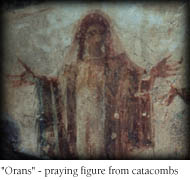The
"orans"
position is used in the logo of the Association of Contemplative
Sisters.
The following is from
a book by Balthasar Fischer. Prof. Fischer is now in his upper
eighties, still does research and writing at the liturgy
institute in Trier, Germany, and is known as the "Father of
the Catechumenate" in the United States for his role in
teaching the liturgies and rationale of the stages-and-steps in
adult initiation. This is from his book "Signs, Words and
Gestures" (Pueblo Publishing, 1981):
"Isn't it really
surprising that during the 'presidential prayers' (the opening
prayer or prayer of the day, the prayer over the gifts and the
concluding prayer) and especially during the eucharistic prayer,
the priest at the altar should adopt a posture diametrically
opposed to the one we learned on our mother's lap? We brought our
hands together for prayer and clasped them or pressed them
against one another. At the altar, however, the priest separates
them and holds them up to God like two empty cups: he [sic]
extends his hands.

These two gestures of prayer were introduced into a liturgy of
the Mass at different periods; both are meaningful and legitimate.
To join the hands is to signify that the usual daily activity of
these hands ceases for a moment and the hands come into their
own, and will be, as it were, taking a holiday. Something like a
holiday, after all, begins every time we pray.
But why does the priest do the opposite when he acts as president
of the worshiping community and, in the name of all of us,
pronounces the most important prayers of the Mass? Why does he
extend his hands instead of bringing them together? This gesture
is, in fact, older and more venerable than that of the joined
hands; the latter came into use in the Mass as a gesture of
prayer only in the Middle Ages, north of the Alps. But as early
as the catacombs we find the Church or the soul represented as
praying the way the priest and the faithful prayed at that time:
with extended hands.
When hundreds of
thousands of Eastern Christians went over to Islam, they took
this gesture of prayer with them, and anyone who visits a mosque
will see devout Muslims praying even today with extended hands...
On one occasion I gained new insight into this ancient gesture
when I read somewhere that the Assyrians had a word for prayer
which meant, "to open the fist." The fist, and
especially a fist raised threateningly, is a sign of a
highhanded, even violent person. People grasp things in closed
hands when they are unwilling to let go of them; they use
clenched fists to assault and hurt and, even worse, to beat
others down so that they cannot get up.
Those who pray, however, are saying before God that they are
renouncing all highhandedness, all pride in their own
sufficiency, all violence. They open their fists. They hold up
their empty hands to God: "I have nothing that I have not
received from you, nothing that you have not placed in my empty
hands. Therefore I do not keep a frantic hold on anything you
have given me; therefore, too, I desire not to strike and hurt
but only to give and to spread happiness and joy. For I myself am
dependent on him [sic] who fills my empty hands with his gifts."
This old gesture of prayer, which the reform--thank God! has
retained, is thus a whole sermon in itself. It is a sermon we
must all take to heart, even if we ourselves no longer pray this
way in public. For, at bottom, all of us extend empty hands to
God when we pray. The thought I am trying to convey here is
summed up in the final words that Martin Luther is reported as
having spoken when he was dying: "We are beggars-- that's
the fact."
"Signs, Words and Gestures" (Pueblo Publishing, 1981):


